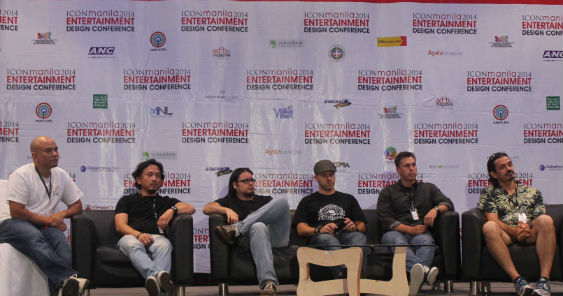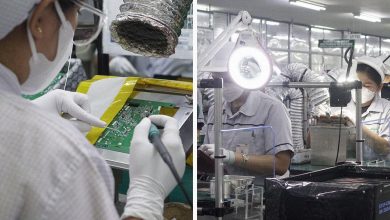John Butiu, James A. Finch, Vance Kovacs, Armand Serrano, Stephen Silver, and Marcelo Vignali shared their passion and design philosophies at the Icon Manila 2014 Entertainment Design Conference, bringing the audience behind the scenes of film industry favourites, including Mulan, Lord of the Rings, Hotel Transylvania, and Frozen.
Vignali, who has contributed on films like Surf’s Up, Cloudy With a Chance of Meatballs, and Hotel Transylvania, began the day’s sessions by talking about production design and art direction. Vignali focused on understanding the visual language, of which there are two types: the language we are taught, and the language we teach. “We take that language that we learn and we apply it in our artwork,” he said, urging designers not to get too caught up in the details.
![]()
“Sometimes we get so interested in design that we lose the big picture, which is that we need to communicate,” he said, stressing the importance of the idea. “In the same way that when you start doing your designs for your work you have to keep in mind, what is it you want to say?” he said.
Vignali closed his talk by reminding the audience to have fun. “Are you having fun? Are you surrendering yourself to the artwork? If you enjoy yourself, your audience is going to enjoy themselves seeing the artwork,” he said.
Following Vignali’s session was Davao-born John Butiu, who talked about 3D animation and modelling. Butiu has worked on a total of 25 films, commercials, and ride films, including Chicken Little, The Return of the King, The Chronicles of Narnia: The Lion, The Witch and the Wardrobe, and Cloudy With a Chance of Meatballs 1 and 2.
Butiu began by sharing his experiences growing up. Until he was five, he lived with his grandparents in Davao. He then joined his family, who had migrated to the United States after he was born. In 1991, his mother died, and he promised to dedicate his life to do his best for her. “I would just never give up and constantly learn and grow,” he said.
Butiu had to drop out in college, which was too expensive, but this did not stop him from pursuing his dreams. “I wanted to work in this industry, in the design and art world,” said Butiu, who taught himself how to use Photoshop.

“Constantly ask questions, constantly look online. The content online is just amazing,” he urged the audience, before showing them how he created the entire San Franjose in Cloudy With a Chance of Meatballs 2 from four sets of buildings.
“The world is just an amazing place right now with technology,” he said, urging the audience to make the most of the available tools.
Next was Serrano, who like Butiu, didn’t start out on the path toward art. A civil engineering graduate of University of Santo Tomas, Serrano said he never even imagined he would be in animation.
He began his career in 1990 at Fil-Cartoons, and eventually landed a job at Walt Disney Animation Studios in Florida. “We all have a purpose. There’s no such thing as coincidences. God has a plan for every one of you,” Serrano said before his talk on visual development, which he defined as the design evolution from concept to the final product.
“You want to make sure that your design is evolving, not devolving. Eliminate what doesn’t work and you keep what works,” he said. Serrano also stressed the importance of the idea: “It’s not just random drawing. There has to be something underneath. There’s an underlying philosophy.”
![]()
Serrano discussed the design pyramid, which has the idea as the foundation, design in the middle, and technique at the top. “This is the foundation that I live by in the business. This is my bible for design,” he said.
After lunch, character designer Stephen Silver–the man behind Kim Possible and Danny Phantom–inspired young artists by sharing his story and ten lessons he learned throughout his career.
The first lesson that Silver shared is to be prepared. He explained that it can be as simple as having business cards to hand out to potential clients. Silver also said that it is important to have the passion, have skill, and develop the skills through practice.
![]()
Another lesson Silver learned is to have the vision. He also stressed the importance of being persistent, being patient, having courage, and having confidence. Finally, Silver said it is important to concentrate: “You can only work on one thing at a time.” “Do not procrastinate,” he added. “Do not wait to be chosen.”
Silver said that when it comes to designing characters, it helps to develop a habit for keen observation. He encouraged artists to sit at a coffee shop, a sidewalk, or a shopping mall and examine the way people dress and move. The way Silver put it, practice and repetition are key to becoming a good artist. “There are no shortcuts to all this,” he said. “There are shortcuts in the technical terms, but there are no shortcuts to getting better.”
Next was Kovacs, who shared his experiences as an illustrator, cover artist, creative designer, and concept artist for film, games, theme parks and publishing. “My career has been pretty eclectic. I’ve never been pigeonholed into one thing,” said Kovacs, whose film projects include Thor, Men in Black 3, Snow White & The Huntsman, all of the Narnia films, and the Dawn of the Planet of the Apes.
![]()
He talked about life as a freelancer, saying that getting your work rejected is part of it. “It’s nice when you get to see your thing on the screen, but it’s rare. There’s a lot of factors that get balanced out,” he said. Regardless of what happens to the work in the end, Kovacs said it’s important to be happy with what you do. “When I go to bed, I want to feel like I did the piece I wanted to do,” he said.
Kovacs talked about working toward mastery, saying everyone begins at the point of unconscious incompetence. “You’re drawing pictures and they’re horrible and you don’t know it. That’s where we all begin,” he said.
The goal, he said, is to move into unconscious competence, which is when you’re great and you don’t have to think about it. Kovacs said great art has two sides: craft, and creativity. “One without the other is mindless, and without the other is soulless. It’s like the heart and the mind,” he said.
Closing the day’s sessions was production designer and visual development artist James A. Finch, who has worked on films such as Frozen, Tarzan, Atlantis, Treasure Planet, and Brother Bear 2.
![]()
“To develop the world (of a story) is a unique thing, because it allows you to do different things,” Finch said. He talked about the process, saying the goal is to come up with a film that people get lost in. “All of these need a good story or something that has an emotional value. That’s always something we strive for,” he said.
Finch also shared some advice, such as, “Your vision, your world are your greatest assets for creation because no one can take that away from you.”
The conference ended with a Q&A with all the speakers. ICON Manila 2014 was held on July 3 at SMX Convention Center, Manila.










